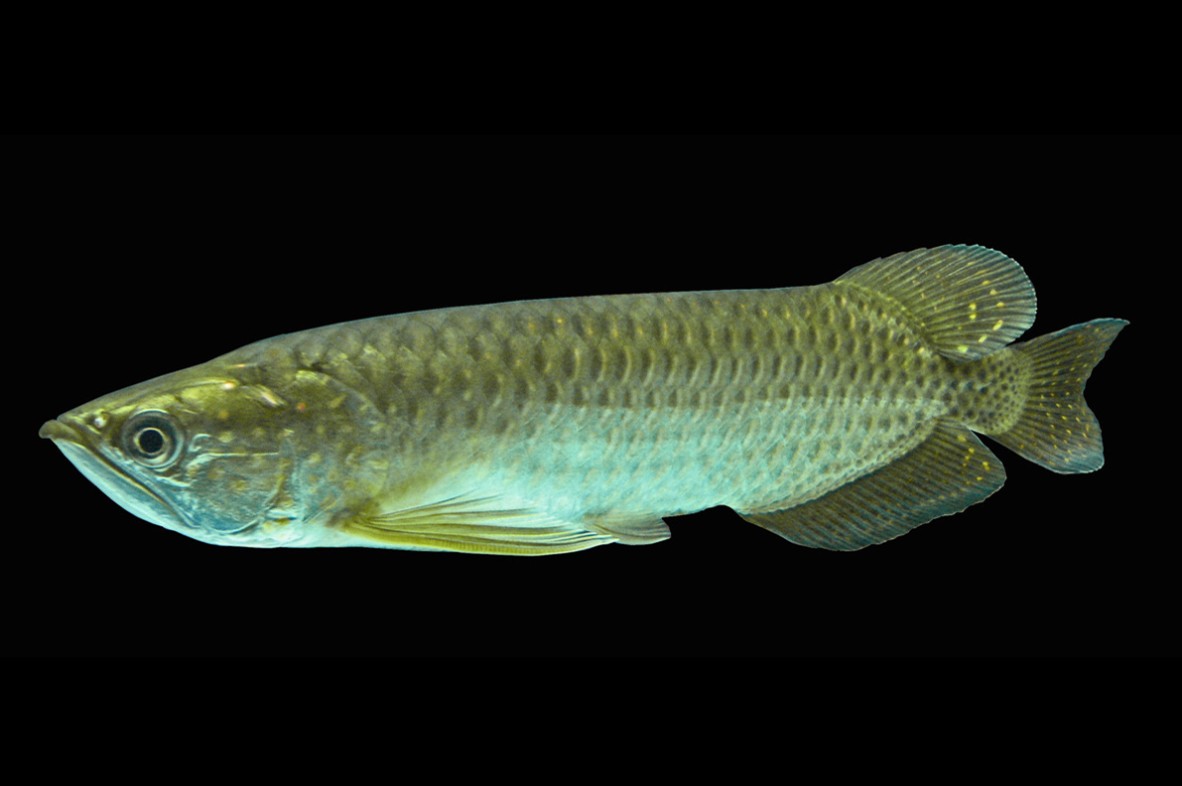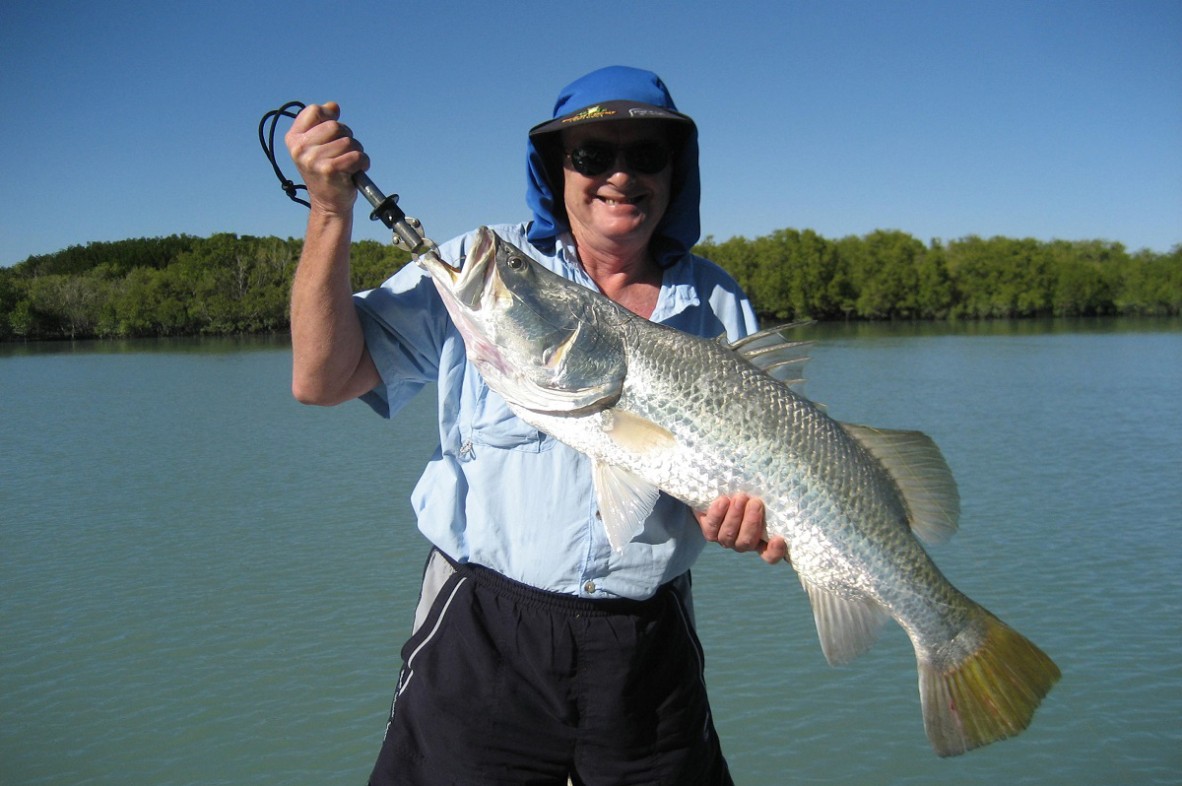State Library receives many queries regarding Aboriginal and Torres Strait Islander languages, particularly in relation to words and their meaning and origin. I thought I would share a recent query regarding the meaning and origin of the word Barramundi; in particular, which language group was the word from?
Now, that seems fairly straightforward - like most people, I'm aware of the fish as a delicacy found in Queensland restaurants, and I've been fortunate to have caught a couple of barra on Cape York and again like most people, I recognise that it is probably an Aboriginal word from one of the Queensland languages. However, the origins and meanings are nearly as murky as a mangrove estuary on Cape York!
The first references to Barramundi commence from the 1840's with Ludwig Leichhardt collecting two specimens of a fish at the Dawson River called 'burramundi' by local Aboriginal groups. In 1864, in recognition of the find, Gunther has named the species Scleropages leichardt - it is also known as the Southern Saratoga! Fishes of Australia as the ultimate reference guide to Australian fishes advises that the Southern Saratoga, Scleropages leichardti Günther 1864, is also known as Barramundi, Burramundi, Dawson River Salmon, Saratoga, Spotted Barramundi and Spotted Saratoga.
Hmmm .... so what is a barramundi?

Southern Saratoga, Scleropages leichardti Günther 1864. Fishes of Australia.
The above image from Fishes of Australia depicts the Southern Saratoga which is clearly distinct from what is popularly known as the Barramundi.
Between 1860-1890's there is quite a bit of discussion on what is a Barramundi - several writers insist that the 'true Barramundi' is only found on the Dawson and it is also known as the Dawson River Salmon. The 1881 publication Descriptive catalogue of Australian Fishes also references Scleropages leichardti as "Burramundi" of the Aborigines of the Dawson River. Gilbert Whitley from the Australian Museum had an interest in Aboriginal names for fishes and writes 'Burramundi' was soon debased to Barramundi through a process known as word-contagion. In 1915, Dr Bancroft fishing on the Dawson noted the Barramundi was difficult to catch due to the bony nature of the mouth and tongue. Bancroft went on to say 'first discovered by Leichhardt, after whom it was named, this is the original barramundi of the (A)borigines, although the word has been applied ot other large-scaled fish, including the lung-fish or ceratodus'.

A Barramundi, Lates calcarifer, from the Lawley River, Kimberley, Western Australia. Source: Geoff Whalan / Flickr.
The image above shows a fish that is popularly known as Barramundi caught in the Kimberley region of Western Australia, so the word has travelled far and wide from its' origins of Central Queensland. This species is Lates calcarifer known in Australia by several names, including Barra, Barramundi, Palmer Perch; while overseas it is also called Giant Sea Perch or Asian Sea Bass.
Entry for ''Burramundi'', A Dictionary of Austral English (1898).
The image above shows the entry for "Burramundi" in The Dictionary of Austral English compiled in 1898 by Professor Morris of the University of Melbourne. The text provides a snapshot of the background to the word and its usage, highlighting the incorrect use for the 'large tidal perch' of the Fitzroy River. This practice of shared or borrowed words is not uncommon in Aboriginal languages - examples include yarraman as a word for horse across Eastern Australia and kangaroo used widely across Australia; while a local South-East Queensland word dibing or deebing which depending on the language group can refer to a mosquito, a horse-fly, a sand-fly, or a midge - essentially any insect that stings!
So there you have it, the original burramundi from Gangulu language referred to the Southern Saratoga or Dawson River Salmon.
Desmond Crump
Indigenous Languages Coordinator, State Library of Queensland
State Library of Queensland Aboriginal and Torres Strait Islander Languages Webpages
State Library of Queensland Aboriginal and Torres Strait Islander Languages Map
Spoken: Celebrating Queensland languages exhibition
Jarjum Stories exhibition
Minya Birran: What next for Indigenous Languages?
Additional material for this blog post was drawn from Fishes of Australia website
Images
Cover image: 'Fisherman', Work by Waylon Butcher aged 7, from Lockhart State School, Lockhart, Queensland Australia. Created as part of the project 'One Sun, One World - Many Dreams 2016'. Artist's statement: When I grow up, I want to be a barramundi fisherman. The barra is hiding under the dugong. Image number: 7116-0014-0098
Southern Saratoga. Gomon, M.F. & Bray, D.J. 2016, Scleropages leichardti in Fishes of Australia, accessed 25 Aug 2020, http://136.154.202.208/home/species/3293
Barramundi. Gomon, M.F. & Bray, D.J. 2017, Lates calcarifer in Fishes of Australia, accessed 25 Aug 2020, http://136.154.202.208/home/species/4643
Entry for Burramundi from Morris, E. (1898) Austral English A dictionary of Australasian words, phrases and usages with those aboriginal-Australian and Maori words which have become incorporated in the language, and the commoner scientific words that have had their origin in Australasia. Online access via One Search.
References and Further Reading
Research for this blog post was drawn from State Library collections and TROVE Newspaper articles to gain an insight into the origins, meanings and usage of the word barramundi.
Bancroft, T. L. (1915) "Some preliminary notes on the Dawson River Barramundi Scleropages leichardti." in Proceedings of the Royal Society of Queensland for 1916, Vol 28. S 500 009 Available online via One Search.
Breen, G. (2009) “The Biri dialects and their neighbours”. Transactions of the Royal Society of South Australia, V133, No.2. SER 506.942
Curr, E. M. (1887) The Australian Race: its origins, languages, customs, place of landing in Australia and the routes by which it spread itself over that continent. RBF 572.994 cur
Dixon, R. M. W., Moore, B., Ramson, W. and Thomas, M. (2006) 2nd edn. Australian Aboriginal Words in English. J 499.15 AUS
Holmer, N. (1983) Linguistic Survey of South-Eastern Queensland. J 499.15 HOL
Morris, E. (1898) Austral English A dictionary of Australasian words, phrases and usages with those aboriginal-Australian and Maori words which have become incorporated in the language, and the commoner scientific words that have had their origin in Australasia. Online access via One Search.
Roth, W. E. (1898-1903) "Reports to the Commissioner of Police and others, on Queensland aboriginal peoples 1898-1903." FILM 0714
Terrill, A. (1998) Biri. J 499.15 TER
Whitley, G. P. (1936) "Aboriginal names mostly of marine animals from North Queensland", in Mankind, Vol. 2., No. 2. S 572 007
Whitley, G. (1940) The Fishes of Australia. J 537.7 WHI
Whitley, G. (1960) Native Freshwater Fishes of Australia. OSG 597.0994 1960
Websites
Australian Institute of Aboriginal and Torres Strait Islander Studies (AIATSIS)
Central Queensland Language Centre
Fishes of Australia website
NLA - TROVE Newspapers - a range of newspaper articles were sourced, including the following:
- The Sydney Morning Herald, 8 October 1862 "Pisciculture"
- The Mercury (Hobart), 10 June 1867 "At one of Leichhardt's Camp"
- The Bulletin, 14 May 1898 "Aboriginalities"
- The Sydney Mail and NSW Advertiser, 20 September 1905 "Barramundi"
- The Brisbane Courier, 9 July 1927 "The Barramundi"
- The Daily Mercury (Mackay), 15 August 1953 "Wrong names used"
Comments
Your email address will not be published.
We welcome relevant, respectful comments.